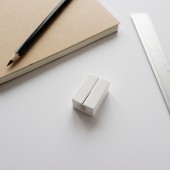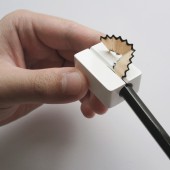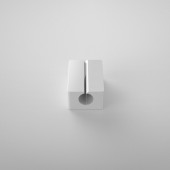
| THE AWARD |
| CATEGORIES |
| REGISTRATION |
| SUBMIT YOUR WORK |
| ENTRY INSTRUCTIONS |
| TERMS & CONDITIONS |
| PUBLICATIONS |
| DATES & FEES |
| METHODOLOGY |
| CONTACT |
| WINNERS |
| PRESS ROOM |
| GET INVOLVED |
| DESIGN PRIZE |
| DESIGN STORE |
| THE AWARD | JURY | CATEGORIES | REGISTRATION | PRESS | WINNERS | PUBLICATIONS | ENTRY INSTRUCTIONS |
Zro2 Pencil Sharpener by Bryan Wong |
Home > Winners > Design #51619 >Interview |
 |
|
FS: What is the main principle, idea and inspiration behind your design?
BW: We believe that a pencil sharpener made with beautiful and durable material is functional hence leads to desirability. In everyone’s childhood, one of the first objects they encounter is a pencil and a pencil sharpener. Standing over the trash bin and sharpening your tool, and make your marks on paper. This interaction can be related to everyone across different cultures and background. We think that the pencil sharpener is a work of beauty — it’s a piece that expresses simplicity and the magic of analog. A pencil sharpener is honest, and as you sharpen your pencil, you see the graphite and wood shavings fly out one turn at a time. Our goal was to reinterpret the analog pencil sharpener that we’re already familiar with, a product that we trust and use everyday.
FS: What has been your main focus in designing this work? Especially what did you want to achieve?
BW: The main focus was to celebrate the beauty of simplicity, and the magic of analog, while redesigning a pencil sharpener — a familiar product that we trust and use everyday.
FS: Why did you design this particular concept? Was this design commissioned or did you decide to pursuit an inspiration?
BW: It started off as a design challenge for ourselves — how can we redesign a familiar product that expresses simplicity and the magic of analog while creating desirability. We chose pencil sharpener as it relates to everyone across different cultures and background.
FS: What made you design this particular type of work?
BW: We wanted to challenge ourselves and believe that a thoughtful product should also provide the best use of material to accentuate the design. By utilizing zirconia's material property, the blade doesn't need to be changed and offers a smooth sharpening experience.
FS: Where there any other designs and/or designers that helped the influence the design of your work?
BW: This project was created in collaboration with industrial designer Chengtao Yi. We worked in unison and compliments each other skills.
FS: Who is the target customer for his design?
BW: Anyone who appreciates the beauty of simplicity and the magic of analog. This design also allows people to display it proudly on their desk and not hidden away in their drawers.
FS: What sets this design apart from other similar or resembling concepts?
BW: Existing products in the market are assembled from different parts; body, blade, and screw. Although sharpeners are easily assembled from a few parts, people never disassemble it to either sharpener or replace the blade. Eventually, they are thrown out and ends up in our landfill. Our design will last a lifetime. The blade and body are made from zirconia and fused into a single unibody block. By utilizing zirconia's material property, the blade doesn't need to be changed and offers a smooth sharpening experience.
FS: How did you come up with the name for this design? What does it mean?
BW: Instead of giving this design a special name, we named it by what it literally is — a pencil sharpener made from zirconia. We wanted to stay true and be honest with our customers.
FS: Which design tools did you use when you were working on this project?
BW: We used SolidWorks to model the form and used Autodesk Fusion 360's simulation tool to run and validate different tests. We've SLA-3D printed multiple prototypes to find the right size, ratio, and grip to ensure it's as beautiful as it sharpens smoothly.
FS: What is the most unique aspect of your design?
BW: The unique aspect of our design is the durability of zirconia, as well as the use of one single material.
FS: Who did you collaborate with for this design? Did you work with people with technical / specialized skills?
BW: This project was created in collaboration with industrial designer Chengtao Yi. We worked in unison and compliments each other skills.
FS: What is the role of technology in this particular design?
BW: We've used different software to model the form and run different simulations to validate our concept. By using software simulations, we were able to validate the design without producing extra prototypes and thus reducing waste.
FS: Is your design influenced by data or analytical research in any way? What kind of research did you conduct for making this design?
BW: Luckily, one of Bryan's brother is a dentist student and his master thesis is about zirconia and it's material properties. This greatly propelled us in the design process as it gave us insights, research data, as well as experiments that we can base on.
FS: What are some of the challenges you faced during the design/realization of your concept?
BW: The biggest challenge for us is the lack of experience with zirconia. It's a premium, exotic material that isn't easily accessible. We had to contact multiple suppliers and manufacturers to source the material as well as prototyping.
FS: What did you learn or how did you improve yourself during the designing of this work?
BW: We've learned a lot throughout this project, notably, how products made with beautiful and durable material leads to desirability.
FS: Thank you for providing us with this opportunity to interview you.
A' Design Award and Competitions grants rights to press members and bloggers to use parts of this interview. This interview is provided as it is; DesignPRWire and A' Design Award and Competitions cannot be held responsible for the answers given by participating designers.
| SOCIAL |
| + Add to Likes / Favorites | Send to My Email | Comment | View Press-Release |




